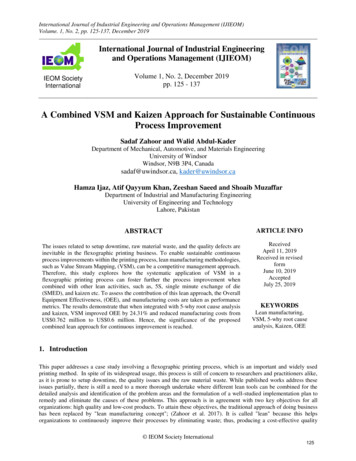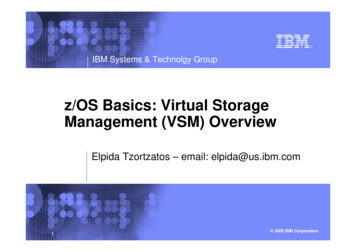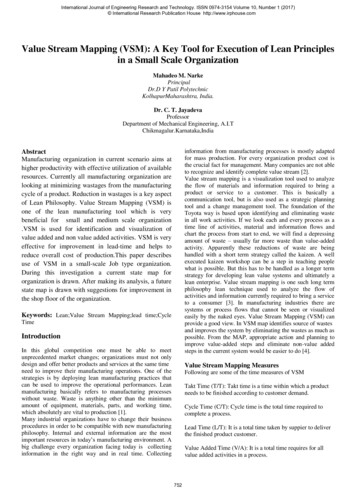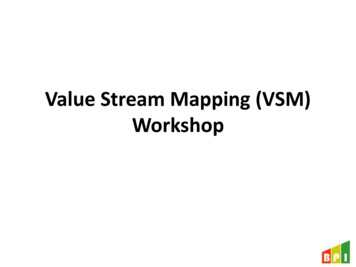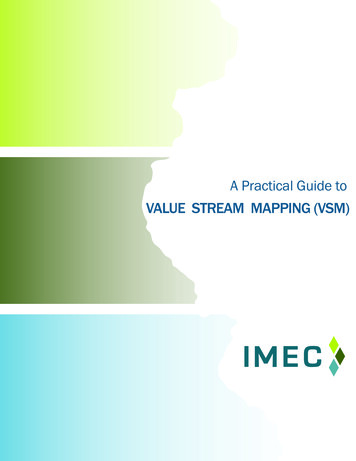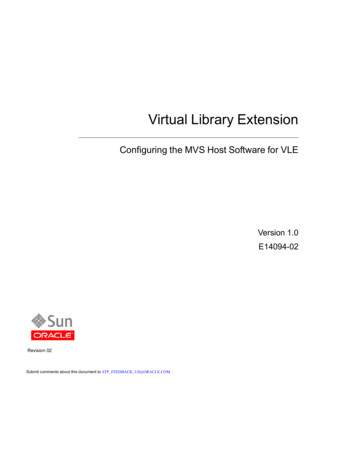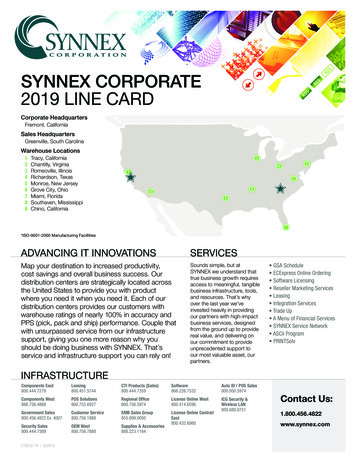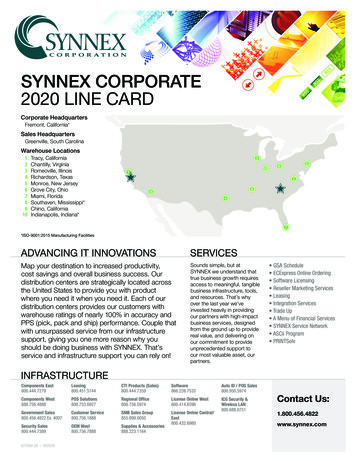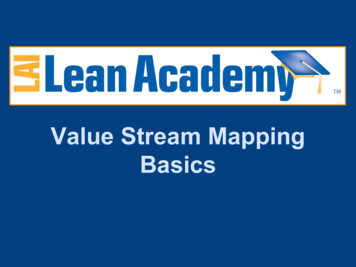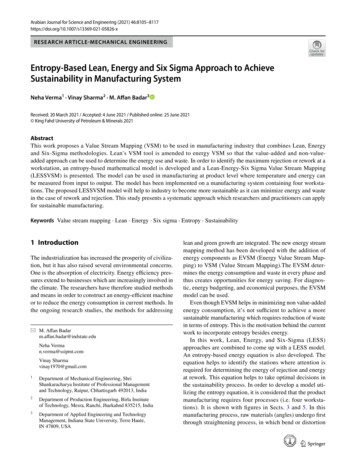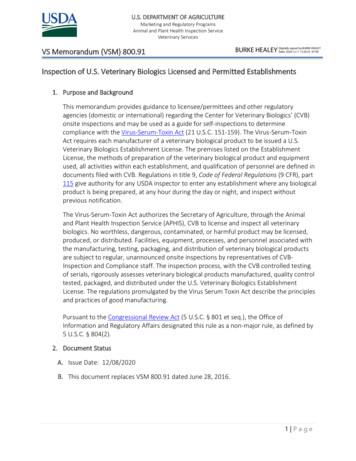
Transcription
U.S. DEPARTMENT OF AGRICULTUREMarketing and Regulatory ProgramsAnimal and Plant Health Inspection ServiceVeterinary ServicesVS Memorandum (VSM) 800.91signed by BURKE HEALEYBURKE HEALEY DigitallyDate: 2020.12.11 15:20:33 -07'00'Inspection of U.S. Veterinary Biologics Licensed and Permitted Establishments1. Purpose and BackgroundThis memorandum provides guidance to licensee/permittees and other regulatoryagencies (domestic or international) regarding the Center for Veterinary Biologics’ (CVB)onsite inspections and may be used as a guide for self-inspections to determinecompliance with the Virus-Serum-Toxin Act (21 U.S.C. 151-159). The Virus-Serum-ToxinAct requires each manufacturer of a veterinary biological product to be issued a U.S.Veterinary Biologics Establishment License. The premises listed on the EstablishmentLicense, the methods of preparation of the veterinary biological product and equipmentused, all activities within each establishment, and qualification of personnel are defined indocuments filed with CVB. Regulations in title 9, Code of Federal Regulations (9 CFR), part115 give authority for any USDA inspector to enter any establishment where any biologicalproduct is being prepared, at any hour during the day or night, and inspect withoutprevious notification.The Virus-Serum-Toxin Act authorizes the Secretary of Agriculture, through the Animaland Plant Health Inspection Service (APHIS), CVB to license and inspect all veterinarybiologics. No worthless, dangerous, contaminated, or harmful product may be licensed,produced, or distributed. Facilities, equipment, processes, and personnel associated withthe manufacturing, testing, packaging, and distribution of veterinary biological productsare subject to regular, unannounced onsite inspections by representatives of CVBInspection and Compliance staff. The inspection process, with the CVB controlled testingof serials, rigorously assesses veterinary biological products manufactured, quality controltested, packaged, and distributed under the U.S. Veterinary Biologics EstablishmentLicense. The regulations promulgated by the Virus Serum Toxin Act describe the principlesand practices of good manufacturing.Pursuant to the Congressional Review Act (5 U.S.C. § 801 et seq.), the Office ofInformation and Regulatory Affairs designated this rule as a non-major rule, as defined by5 U.S.C. § 804(2).2. Document StatusA. Issue Date: 12/08/2020B. This document replaces VSM 800.91 dated June 28, 2016.1 Page
U.S. DEPARTMENT OF AGRICULTUREMarketing and Regulatory ProgramsAnimal and Plant Health Inspection ServiceVeterinary ServicesVS Memorandum (VSM) 800.913. Reason for ReissuanceA. This was updated for clarity and consistency with other regulatory documents byadding definitions related to quality management and good manufacturing practices.Issuance of a Certificate of Inspection issued by CVB is also introduced in thisguidance document.4. Authority and ReferencesA. Authorities Virus-Serum-Toxin Act (37 Stat. 832-833, 21 U.S.C. 151-159) 7 CFR 371.4 9 CFR 101 9 CFR 102 9 CFR 103 9 CFR 104 9 CFR 105 9 CFR 108 9 CFR 109 9 CFR 112 9 CFR 113 9 CFR 114 9 CFR 115 9 CFR 116 9 CFR 117B. References Animal Welfare Act Global Regulatory Framework Document. A guide created by Animal HealthInstitute (AHI) that compares the USDA methods/regulations to the Rules andGuidance for Pharmaceutical Manufacturers and Distributors (the OrangeBook) compiled by the Inspection, Enforcement and Standards Division ofMedicines & Health products Regulatory Agency and the Guide to GoodManufacturing Practice for Medicinal Products, prepared by thePharmaceutical Inspection Convention, Pharmaceutical Inspection Cooperation Scheme (PICs). AHI is responsible for posting and maintaining thisdocument. VSM 800.53, Release of Biological Products VSM 800.56, Disposal of Unsatisfactory and Undesirable Materials VSM800.57, Market Suspensions and Post Marketing Temperature Deviations VSM 800.59, Veterinary Biological Product Samples2 Page
U.S. DEPARTMENT OF AGRICULTUREMarketing and Regulatory ProgramsAnimal and Plant Health Inspection ServiceVeterinary ServicesVS Memorandum (VSM) 800.91 VSM 800.60, Biological Products Returned to Licensed EstablishmentsVSM 800.63, Personnel at Licensed EstablishmentsVSM 800.64, Preparation of Experimental Products at Licensed EstablishmentsVSM 800.74, Preparation and Distribution of Sterile DiluentsVSM 800.78, Preparation and Submission of Facilities DocumentsVSM 800.115, Potency and Safety Testing by Unlicensed FacilitiesVSM 800.116, Target Animal Safety Testing ExemptionVSM 800.210, Manufacturing Deviations Identified Prior to Marketing ReleaseC. Definitions1) Quality Management is a wide-ranging concept covering all matters thatindividually or collectively influence the quality of a product. Manufacturersassume the responsibility for the quality of the veterinary biological productand that the product is fit for the intended use, as demonstrated during thelicensing process, and comply with all applicable requirements throughout theproduct’s life cycle.2) Quality Assurance is the totality of actions within the organization supportingquality management.3) Good Manufacturing Practice is a system to ensure products are consistentlyproduced and controlled. CVB oversight regarding periodic review of thelicensee/permittee control is twofold. Sample submission and check testing byCVB provides one method of control. The second method is by routine onsiteinspections.4) Quality Control is the procedures used to ensure starting material, in-processmaterial, and final use product conform to the established specificationsrequired for consistent production.5) Quality Risk Management is a systematic process to assess, control,communicate, and review the risks to the quality of the product across theproduct’s life cycle. It is used to develop the control strategy for each stage ofmanufacturing, from starting material to final distributed product.6) Validation is the action of scientifically proving the procedures, processes,equipment, material, activities, and systems lead to the results of delivering aquality product. This includes continual assurance that a process remains in astate of control. Some examples are: Cleaning procedures Testing procedures Production processes3 Page
U.S. DEPARTMENT OF AGRICULTUREMarketing and Regulatory ProgramsAnimal and Plant Health Inspection ServiceVeterinary ServicesVS Memorandum (VSM) 800.91 Equipment useComputer systems7) Calibration is the demonstration that a particular instrument or deviceproduces results within specified limits by comparison with those produced bya reference or traceable standard over an appropriate range ofmeasurements.8) Data Integrity is the overall accuracy, completeness, and consistency of data.5. AudienceVS employees and members of the biologics industry.6. GuidanceA. Process1) The inspection performed by CVB inspectors is in part to determine productswere produced and tested by competent people using acceptable facilities,equipment, and validated processes.2) The inspection includes audits of related records, observations to substantiateinformation on file with CVB, and perambulation of ongoing operations.B. Findings1) Findings are listed under one of the 14 categories of inspection found insubsequent sections of this guidance.a. Violations will be cited as per 9 CFR and may include the applicable sectionnumbers. Additional 9 CFR citations may also apply.b. Violations will be classified as Serious, Less Serious, or Minor.i. Serious – Violations of this degree may affect the quality of the product orproducts or may be willful.ii. Less Serious – By repetition or situation, may affect quality of a product.iii. Minor – Are not apt to affect quality of product but indicate laxity or errorthat could become more serious if not corrected. Numerous minorexceptions noted during the inspection indicate poor quality managementand should be considered as having cumulative effect.4 Page
U.S. DEPARTMENT OF AGRICULTUREMarketing and Regulatory ProgramsAnimal and Plant Health Inspection ServiceVeterinary ServicesVS Memorandum (VSM) 800.91c. The findings documented as a result of audits and observations for eachinspection category should not be considered limiting or all-inclusive.2) CVB Inspectors provide a summary of finding to the regulated entity after each indepth inspection.3) A written response from the licensee/permittee regarding corrective andpreventive actions taken for the documented findings are required be submittedto CVB. This may require more than one response from the licensee/permittee.4) Certificates of Inspection may be issued indicating the manufacturing sites wereinspected under the laws of the United States of America and comply with theprinciples and practices of USDA good manufacturing.C. Following is the list of inspection categories, with audits and observations for each.The list also includes information that may be reviewed during the annualAdministrative Inspection Reviews. APHIS inspectors may use this list for guidancewhen conducting inspections. These items may also be beneficial for establishing selfinspections. The overarching regulation regarding inspection of establishments is9 CFR 115.1.1) Licenses and Permitsa. Auditsi.Review the ownership, parent company, and subsidiary and divisionrelationships with the firm’s official in charge. If applicable, discuss anyfuture changes or mergers and impacts to production and testing.[Reference: 9 CFR 114.1]ii.Verify addresses, locations, and other information on the license. Confirmall stages of production are conducted within licensed premises.[Reference: 9 CFR 114.1]iii.Review U.S. Veterinary Biological Product Permits for Research andEvaluation and any permits for the importation or transportation oforganisms or vectors issued to the licensee and compare with informationon file at CVB.1. Ask for any additional permits the firm may have.2. Audit the firm’s records for compliance with special requirements listedon the permits and with the regulations covering importation forresearch and evaluation.5 Page
U.S. DEPARTMENT OF AGRICULTUREMarketing and Regulatory ProgramsAnimal and Plant Health Inspection ServiceVeterinary ServicesVS Memorandum (VSM) 800.913. Determine if any of the permits expired.b. Observationsi. Note the location of buildings and equipment used to produce, test, andstore products to be sure that all premises are properly identified on theestablishment license. Note any change in ownership, location, oroperation of the establishment. [Reference: 9 CFR 108.1]ii. Verify every product observed in production or testing on the licensedpremises has a license or permit. Ensure products prepared under theFood and Drug Export Reform and Enhancement Act do not adverselyimpact the preparation of licensed/permitted veterinary biologicalproduct. [Reference: 9 CFR 114.2(b)]iii. If applicable, review non-biological products prepared in the facility anddetermine if there is any adverse impact to the preparation oflicensed/permitted veterinary biological product. [Reference: 9 CFR 103.1]iv. Review permit restrictions and determine if the permittee is in compliancewith these restrictions for imported products for distribution and sale.v. Inspect facilities where research material imported under permit ishandled, and the conditions for handling this material, to be sure theymeet requirements. Check for any other imported biologics on thelicensed premises. Biologics exported from the United States may only bereturned under a permit for research and evaluation. [Reference: 9 CFR104.4]c. Administrative Inspection Reviewi.Licensees/permittees compare information on file regarding the firm'sU.S. Veterinary Biologics Establishment License for the establishment, andif applicable, the sites. [Reference: 9 CFR 102.1 or 104.1]ii.Activity of each licensed product, including conditional licenses1.If a product is not being produced, determine the last date ofproduction. The firm may wish to voluntarily return inactive productlicenses for which they no longer have the equipment, facilities,and/or expertise to prepare to APHIS for termination. [Reference: 9CFR 105.4]6 Page
U.S. DEPARTMENT OF AGRICULTUREMarketing and Regulatory ProgramsAnimal and Plant Health Inspection ServiceVeterinary ServicesVS Memorandum (VSM) 800.912.Review for terminated conditional licenses [Reference: 9 CFR102.6(a)]2) Personnela. Auditi. Request a current copy of the firm’s organizational chart or obtaininformation on official lines of responsibility within the firm.1. Review the relationships between production, testing, marketing, andquality assurance. The responsible managers of production and qualitycontrol must be independent from each other.2. Review spans of responsibility to ensure they are not so extensive asto present a risk to quality.3. Review gaps or unexplained overlaps in personnel responsibility.Senior management has the ultimate responsibility to ensurecompliance with the regulations.ii. Review the firm's process of determining who should have an APHIS Form2007 on file with CVB and the system used to maintain the listing. Identifythe person responsible for periodically reviewing the APHIS Form 2007file. [Reference: 9 CFR 114.7(a)]iii. Review training records for essential functions conducted regardinglicensed/permitted products. [Reference: 9 CFR 114.7(b and c)]1.All personnel (including those concerned with cleaning andmaintenance) employed in the areas where products aremanufactured should be given training in and information onmicrobiology, hygiene, and biosafety. They should receive additionaltraining specific to the product with which they work. [Reference: 9CFR 114.7(c)]2.Personnel working in areas where products are manufactured andtested should receive training and periodic retraining specific to theirduties and the products manufactured. [Reference: 9 CFR 114.7(band c)]b. Observationsi. Determine if personnel designated as the official liaison and alternateliaisons, if applicable, are knowledgeable about the day-to-day activities at7 Page
U.S. DEPARTMENT OF AGRICULTUREMarketing and Regulatory ProgramsAnimal and Plant Health Inspection ServiceVeterinary ServicesVS Memorandum (VSM) 800.91the firm and in a position to make agreements with APHIS. [Reference: 9CFR 114.7(a)]ii. Observe if employees in key positions have APHIS Form 2007s on file atCVB. Observe if employees follow lines of responsibility as shown on theorganizational chart or as explained by management. See VeterinaryServices (VS) Memorandum 800.63, Personnel at Licensed Establishments,for additional guidance. [Reference: 9 CFR 114.7(a)]iii. Observe operations to determine if employees, in general, are adequatelytrained and supervised so as to be competent in good laboratorytechniques and preparation of veterinary biological products. Be aware ofpersonnel health conditions that might affect the product. [Reference: 9CFR 114.7(b)]iv. Observe if there is an adequate number of personnel with necessaryqualifications and practical experience available for the functions beingperformed.v. Determine if adequate measures are taken to prevent breaches inbiocontainment or prevention of cross contamination. This may include,but is not limited to, the use of personal protective equipment, change ofclothes, and/or showering before leaving the production area. [Reference:9 CFR 114.7(c)(1)]c. Administrative Inspection Reviewi. Review list of personnel submitted on APHIS Forms 2007s on file with CVB.[Reference: 9 CFR 114.7(a)]1. Review for any key changes in personnel and their responsibilities.2. Review for deletions, additions, or job changes.3. Confirm the names of the official liaison, alternates, and site contacts.ii. Personnel responsible for production and quality control should have anadequate background in relevant scientific discipline, together withsufficient practical experience to enable them to perform their duties.[Reference: 9 CFR 114.7(b)]3) Facilities [Premises]a. Audit8 Page
U.S. DEPARTMENT OF AGRICULTUREMarketing and Regulatory ProgramsAnimal and Plant Health Inspection ServiceVeterinary ServicesVS Memorandum (VSM) 800.91i. Inspect the premises and compare with the facility documents. See VSMemorandum 800.78, Preparation and Submission of FacilitiesDocuments, for additional guidance. [Reference: 9 CFR 108.1]1. Dedicated facilities may be required for manufacturing when riskscannot be adequately controlled by operational or technical measures.2. Premises should be laid out in such a way as to allow production totake place in areas that are connected in a logical order, correspondingto the sequence of the operations and to the requisite cleanlinesslevels. [Reference: 9 CFR 108.8(b)]ii. When comparing facilities with the filed facility documents, look forevidence of unreported remodeling, new stationary equipment, relocatedkey items, and other discrepancies. [Reference: 9 CFR 108.6(a)]iii. Confirm that legends showing special-use facilities (such as a publicdiagnostic clinic, diagnostic facilities, separate and apart research areas,export-only products, pharmaceutics production, and FDA Export Reformand Enhancement Act production) are correct. Determine the location andadequacy of isolation facilities for incoming animals, if required.[Reference: 9 CFR 108.8(c), 117.3(a), 117.3(e)]iv. Evaluate the site’s qualification processes for facilities, equipment, andutilities. Determine if the qualification and validation principlesincorporate the critical process parameters and critical quality attributesneeded for the production of veterinary biological products. [Reference: 9CFR 102.4(a)]b. Observationsi. Verify the premises design, as listed in the blueprint documents, is actuallybeing operated in compliance with the information on file. Processes musthave adequate and appropriate isolation for each product to preventcross-contamination from other products. Evaluate operations for anypossible adverse effect on the product. [Reference: 9 CFR 108.8(b)]1. Ensure other operations where live biological agents are handled,including organisms used in quality control, are appropriate,contained, and separated if production is operated in the samebuilding. The measures used to prevent cross-contamination should becommensurate with the risks. [Reference: 9 CFR 108.8(c)]9 Page
U.S. DEPARTMENT OF AGRICULTUREMarketing and Regulatory ProgramsAnimal and Plant Health Inspection ServiceVeterinary ServicesVS Memorandum (VSM) 800.91a) Live biological agents should be handled in rooms orcompartments to contain the agent. [Reference: 9 CFR 108.8(c)]b) Ensure authorized diagnostic facilities at the licensedestablishment follow safeguards to mitigate the risks ofcontamination with pathogenic organisms. [Reference: 9 CFR117.3(e)]2. Observe traffic patterns through the production area. Prevention ofcross-contamination by personnel should be achieved by a set ofmeasures and procedures to eliminate risk. This may include the use ofair locks for personnel and equipment. Observe enforcement ofmovement restrictions. Restricted areas should be posted as such.[Reference: 9 CFR 108.8(b)]3. Animal facilities should be well isolated from other areas, withseparate entrances and air handling. [Reference: 9 CFR 117.1(b)]ii. Observe that premises are carefully maintained; the material,construction, and finish of all areas related to the production of biologicalproducts or ingredients of biological products can be thoroughly cleaned.[Reference: 9 CFR 108.8(a)]1. Walls, floors, and ceilings in areas where product is exposed must besmooth and free of cracks or open joints.2. Pipework, light fittings, ventilation points, and other services should bedesigned to avoid recesses which are difficult to clean.iii. Observe the adequacy of the working and in-process storage space topermit the orderly and logical positioning of equipment and materials soas to minimize the risk of errors between different products, antigens,and/or components; to avoid cross contamination; and mitigate the risk ofomission or wrong application of any manufacturing or control steps.[Reference: 9 CFR 108.8(b)]iv. Ensure repairs, maintenance, or remodeling operations do not present ahazard to the quality of products. [Reference: 9 CFR 108.6]v. Verify lighting is appropriate and such that it does not adversely affect,either directly or indirectly, the preparation, testing, storage of product, oraccurate functioning of equipment. [Reference: 9 CFR 108.4(g)]10 P a g e
U.S. DEPARTMENT OF AGRICULTUREMarketing and Regulatory ProgramsAnimal and Plant Health Inspection ServiceVeterinary ServicesVS Memorandum (VSM) 800.91vi. Verify an adequate supply of hot and cold water and ensure efficientdrainage and plumbing systems for production and testing purposes.Ensure drains are properly installed with approved traps and vents and arefunctioning as expected. Open channels should be avoided wherepossible, but if needed, they should be shallow to facilitate cleaning anddisinfection. [Reference: 9 CFR 108.8(e) and (f)]vii. Verify the heating, ventilation, and air conditioning systems are sufficientto adequately address issues of biocontainment and mitigate crosscontamination for the protection of products and personnel. [Reference: 9CFR 108.8(d)]viii. Verify that dressing rooms, toilet facilities, and lavatory accommodationsare appropriately placed, sufficient in number, and separated fromproduction. Soap, towels, and hot water should be available. [Reference: 9CFR 108.9]ix. Verify adequate biosafety measures are taken to prevent infection ofpersonnel working with zoonotic agents. [Reference: 9 CFR 108.8(c) and(d)]c. Administrative Inspection Reviews – not applicable to this category unlessrelated to specialized questions during the annual review.4) Equipmenta. Auditsi.Identify equipment and environmental rooms used in production,testing, and storage of product. The equipment should be designed,located, and maintained to suit the intended purpose. [Reference: 9 CFR108.4(f)]1. Verify that the location of equipment matches the code designatedin the blueprint legends.2. Confirm the unique identity of equipment through productionrecords, maintenance logs, and operation as intended by themanufacturer of the equipment. Repairs and maintenanceoperations should not present any hazard to the quality of theproducts.11 P a g e
U.S. DEPARTMENT OF AGRICULTUREMarketing and Regulatory ProgramsAnimal and Plant Health Inspection ServiceVeterinary ServicesVS Memorandum (VSM) 800.913. Review the records of operation of specialized equipment,determine if the equipment is functioning properly, and ensurerecordkeeping is in compliance.ii.Verify equipment is cleaned and sterilized according to detailed, writtenprocedures. Determine if sufficient records are maintained. [Reference:9 CFR 116.4]iii.Review records regarding the calibration of equipment at definedintervals.1. Equipment/instrument/device calibrations should be performedusing standards traceable to certified standards from organizationssuch as the National Institute of Standards and Technology ifexisting.2. The results of the calibration must be within the specified limits bycomparison to the traceable standard.3. The calibrated measurement should be within the defined set ofoperating parameters, established under specific conditions for useduring production and testing.iv.Determine what system is used and what records are kept by the firm toensure that automatically controlled equipment is operating properly. Ifthe firm has an exemption from having automatic recorders onsterilizers, determine if the records kept meet the provisions ofregulations. [Reference: 9 CFR 109.2]b. Observationsi.Look for equipment or compartments not shown on the blueprintand/or the blueprint legend. Determine if they are being used inproduction, testing, or storage of product and if the equipment orcompartment is being used and maintained in compliance with theregulations and manufacturer’s recommendations. [Reference: 9 CFR108.5(b)(2)]ii.Observe the operation of equipment and compartments and determineif they are being operated properly. Production equipment should notpresent any hazards to products. If equipment is calibrated, theappropriate range and precision should be available for the operator.12 P a g e
U.S. DEPARTMENT OF AGRICULTUREMarketing and Regulatory ProgramsAnimal and Plant Health Inspection ServiceVeterinary ServicesVS Memorandum (VSM) 800.91iii.Determine if each piece of equipment is uniquely identified so the use ofthe equipment may be adequately documented and traceable in themanufacturing records when used in production.iv.Fixed pipework should be clearly labelled to indicate the contents and,where applicable, the direction of flow.v.Assure that all equipment is being sterilized according to applicablerequirements. [Reference: 9 CFR 109.1]1. Exemptions to the regulations must be on file with CVB. Confirmequipment exempted from sterilization requirements listed in theregulations is being treated as allowed for in the exemption on filewith CVB. See VS Memorandum 800.78, Preparation and Submissionof Facilities Documents, for additional guidance on submitting anexemption.2. Observe equipment design, it should be easily and thoroughlycleaned.c. Administrative Inspection Reviews – not applicable to this category unlessrelated to specialized questions during the annual review.5) Sanitationa. Auditsi. Audit the firm's records to ensure that sanitizing is done at theappropriate time and place, and with the appropriate chemicals, asspecified in the facility’s blueprint legends.ii. Determine if the chemicals used for sanitation are appropriate for themicroorganisms in each room.iii. Ensure adequate biosecurity measures are in place to prevent biologicalagents being taken outside the manufacturing plant by personnel acting asa carrier. [Reference: 9 CFR 114.7(c)(1)]b. Observationsi. The manufacturing environment is operated in such a way as to presentminimal risk of causing contamination of materials or product. [Reference:9 CFR 108.8(b)]13 P a g e
U.S. DEPARTMENT OF AGRICULTUREMarketing and Regulatory ProgramsAnimal and Plant Health Inspection ServiceVeterinary ServicesVS Memorandum (VSM) 800.911. Notice if the outside premises are properly drained, clean, and free ofaccumulated trash or construction debris. [Reference: 9 CFR108.10(a)]2. Note whether an adequate effort is being made to control vermin,especially in animal quarters. [Reference: 9 CFR 108.10(c)]3. Observe for clutter inside the premises. Determine if the clutteraffects product quality. Check for accumulation of unnecessarymaterials, particularly in halls, production rooms, and coolers.ii. Determine if waste disposal methods are in accordance with theapplicable regulations. See VS Memorandum 800.56, Disposal ofUnsatisfactory and Undesirable Materials, for additional guidance.[Reference: 9 CFR 114.15]iii. Every person entering the manufacturing areas should wear protectivegarments as appropriate to the operations being carried out. Note ifspecial clothing requirement areas are posted and requirements enforced.[Reference: 9 CFR 114.7(c)(1)]iv. Watch for unsanitary practices by employees, such as eating, drinking,chewing, smoking, or storage of food, drink, smoking materials, orpersonal medication in the production areas. [Reference: 9 CFR114.7(c)(2)]v. Good aseptic techniques should be used to prevent direct contact withthe product. Appropriate personal protective equipment must be used toavoid direct contact with the operator’s hands and the exposed product,as well as with any part of the equipment that comes into contact with theproducts.c. Administrative Inspection Reviews – not applicable to this category unlessrelated to specialized questions during the annual review.6) Prelicensing - Products Pending Licensurea. Auditsi. Examine records to confirm that the firm has obtained permission fromCVB-Program, Evaluation, and Licensing (PEL) for any research conductedin production facilities with organisms, antigens, or fraction not alreadyapproved for a licensed product. Determine impact to licensed/permittedproduct regarding the preparation of experimental product and review14 P a g e
U.S. DEPARTMENT OF AGRICULTUREMarketing and Regulatory ProgramsAnimal and Plant Health Inspection ServiceVeterinary ServicesVS Memorandum (VSM) 800.91mitigating steps implemented by the firm or required by CVB. Confirmrestrictions or conditions required by PEL were met. See VS Memorandum800.64, Preparation of Experimental Products at Licensed Establishments,for additional guidance. [Reference: 9 CFR 103.1]ii. Verify that the Seed material is adequately identified and accounted for.iii. Review records for proper disposal of animals used in the preparation ortesting of experimental products. [Reference: 9 CFR 117.6]iv. Differentiate between research being conducted using microorganismsrelated to currently licensed products and work with new microorganismsnot related to licensed products. Complete records are required for both,but fewer restrictions may be required for microorganisms related tocurrently licensed products. [Reference: 9 CFR 116.1(a)]v. Review field trial records for compliance with special restrictions andrequirements. Account for product prepared and distributed for fieldtrials. Determine if the product was prepared in accordance with theOutline of Production on file. Determine if all responses were reported toPEL. Determine if the detailed records support the summaries sent to PEL.[Reference: 9 CFR 103.3]vi. Review the minutes of Institutional Biosafety Committee meetings.Determine if appropriate members have been appointed. Determine if allbiotechnology work and especially recombinant product work are beingaddressed and if appropriate policy and proced
Animal and Plant Health Inspection Service Veterinary Services VS Memorandum (VSM) 800.91 5 Page c. The findings documented as a result of audits and observations for each inspection category should not be considered limiting or all-inclusive. 2) CVB Inspectors provide a summary of finding to the regulated entity after each in-depth inspection.
